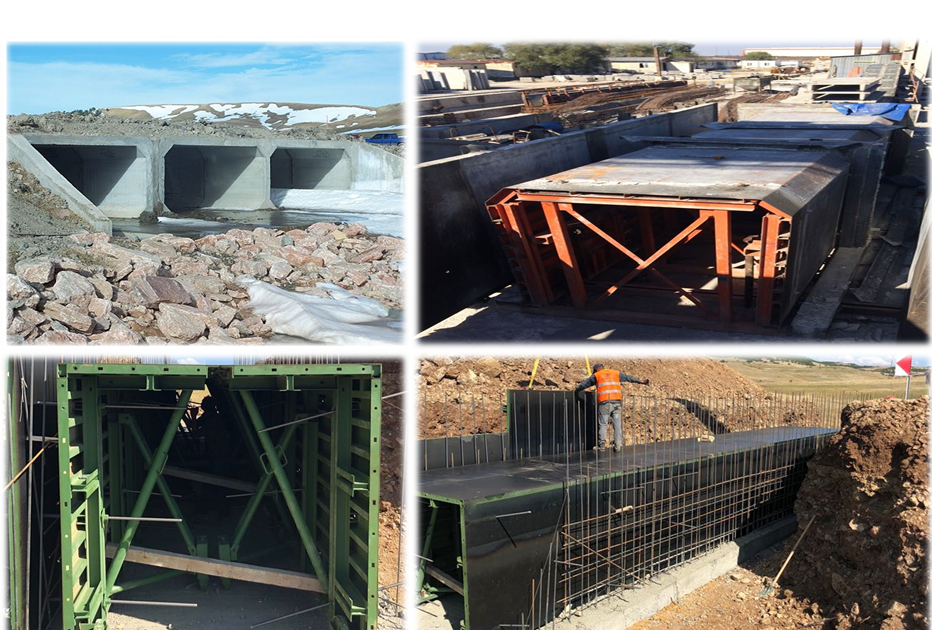Tunnel Formworks and Their Applications
6/18/20245 min read


Tunnel Formworks and Their Applications
Tunnel formwork is a crucial construction method widely employed in the building and infrastructure sectors for creating durable, high-quality concrete structures. This formwork system is particularly known for its efficiency, speed, and cost-effectiveness, especially in the construction of tunnels, bridges, apartment buildings, and other large infrastructure projects. Tunnel formworks allow for the simultaneous casting of walls and slabs, making them a versatile tool in modern construction. This essay will explore the different types of tunnel formworks and their various applications across diverse construction fields.
Types of Tunnel Formworks
There are several types of tunnel formworks, each designed for specific applications and construction needs. These formworks can be categorized based on their design, function, and the type of structures they are used to build.
1. Standard Tunnel Formworks:
Standard tunnel formworks are commonly used in the construction of large-scale projects like tunnels, residential buildings, and infrastructure developments. These formworks consist of a rigid steel or aluminum mold that allows for the simultaneous casting of walls and slabs in a single operation. The process is quick and efficient, with minimal need for scaffolding or other support structures.
Applications:
- Residential Buildings: Tunnel formworks are often used in high-rise residential projects, where the same formwork can be reused to cast identical rooms or apartments on different floors. This repetition ensures high productivity and consistency in quality.
- Commercial Buildings: The system can also be applied to construct office spaces, commercial complexes, and industrial buildings with similar floor layouts.
- Infrastructure Projects: These formworks are often used in the construction of transport infrastructure like tunnels, where large concrete segments need to be cast quickly and efficiently.
2. Hydraulic Tunnel Formworks:
Hydraulic tunnel formworks incorporate hydraulic systems that make moving the formwork to different locations easier, thereby speeding up the construction process. These are especially useful in projects that require the formwork to be moved frequently, such as when constructing long tunnels or large continuous concrete structures.
Applications:
- Tunnels for Transportation: Hydraulic formworks are typically used in the construction of vehicular and railway tunnels, where long, repetitive sections of concrete need to be cast in a short amount of time.
- Underground Passages: These formworks are also used in the construction of underground pedestrian walkways and utility tunnels, providing quick and efficient construction solutions.
3. Segmental Tunnel Formworks:
Segmental tunnel formworks are designed for casting tunnel sections in segments rather than as a continuous whole. This is useful for large tunnel projects where the entire tunnel cannot be cast in a single operation due to structural or logistical reasons.
Applications:
- Subway Systems: Segmental tunnel formworks are commonly used in the construction of subway tunnels, which are often built in sections due to the complexity and size of the project.
- Water Tunnels: In water conveyance projects, segmental formworks are used to build tunnels for water distribution, drainage systems, or wastewater management.
4. Adjustable Tunnel Formworks:
Adjustable tunnel formworks are versatile systems that can be modified to suit different project requirements. These formworks can be adjusted to accommodate variations in tunnel diameter, height, and shape, making them ideal for projects with complex or non-standard designs.
Applications:
- Bridges and Viaducts: In projects involving curved or varying spans, such as bridges or viaducts, adjustable formworks can be used to cast different sections of the structure without requiring a complete redesign of the formwork.
- Hydroelectric Projects: In the construction of tunnels for hydroelectric dams, adjustable formworks are used to accommodate variations in the tunnel's shape as it progresses through different terrain types.
5. Curved Tunnel Formworks:
Curved tunnel formworks are designed specifically for tunnels or structures with curved shapes. These formworks are typically used in projects where the tunnel must follow a specific alignment or where the design requires a curved cross-section.
Applications:
- Road and Rail Tunnels: In mountainous or hilly areas, curved tunnel formworks are essential for constructing road and rail tunnels that follow natural terrain contours.
- Underground Parking Facilities: These formworks are often used in constructing circular or curved underground parking structures that require complex geometry.
6. Circular Tunnel Formworks:
Circular tunnel formworks are designed for constructing tunnels with a circular cross-section, which is often required in water conveyance, sewage systems, and subway projects.
Applications:
- Water Supply Tunnels: Circular tunnels are ideal for transporting water, making this formwork system popular in water supply and drainage tunnel projects.
- Subway Systems: Subway systems often require circular tunnel sections for easy installation of the rail tracks and ventilation systems.
Applications of Tunnel Formworks
Tunnel formworks are applied across various sectors due to their versatility and ability to accommodate large-scale concrete structures. Here are some of the primary applications:
1. Railway and Road Tunnels:
Tunnel formworks are most commonly used in the construction of railway and road tunnels. In railway systems, concrete tunnels provide long-lasting, durable structures that can withstand the load and vibrations caused by passing trains. For roads, concrete tunnels provide safety, reducing the need for frequent maintenance or repairs.
These projects benefit from the speed and efficiency of tunnel formwork systems, which allow for the casting of large sections in short periods, reducing construction time and cost.
2. Residential and Commercial Buildings:
One of the most widespread uses of tunnel formworks is in constructing high-rise residential and commercial buildings. The simultaneous casting of walls and slabs significantly reduces the time required to complete each floor. The resulting monolithic concrete structure provides excellent resistance to seismic forces, making tunnel formworks a popular choice in earthquake-prone regions.
In repetitive structures like apartment blocks or office complexes, tunnel formworks help maintain consistency in quality and speed up the overall construction process.
3. Bridges and Viaducts:
Tunnel formworks are also used in the construction of bridges and viaducts, particularly for casting the supporting piers and cross-sections of the structure. These formworks are especially useful when constructing large spans, as they provide the necessary precision and strength to support the bridge deck.
By enabling the quick casting of large concrete sections, tunnel formworks help to streamline the construction process and improve the overall efficiency of bridge-building projects.
4. Hydroelectric Dams and Water Conveyance Systems:
Tunnel formworks are extensively used in hydroelectric projects, where large concrete tunnels are required to transport water from reservoirs to turbines. The curved and segmental formworks allow for the precise casting of these tunnels, ensuring that they can handle high water pressure and flow.
Water conveyance systems, including drainage and irrigation tunnels, also rely on tunnel formworks for the efficient and quick construction of durable, leak-resistant tunnels.
5. Subway Systems and Underground Infrastructure:
Subway systems and other underground infrastructure, such as pedestrian walkways and utility tunnels, frequently use tunnel formworks. These projects require durable, long-lasting tunnels that can withstand both the weight of the structures above and the vibrations from the trains or other transport systems below.
Tunnel formworks provide the necessary strength and precision for constructing these tunnels, ensuring they remain stable and functional for decades.
Benefits of Tunnel Formworks in Construction
The widespread use of tunnel formworks is due to the numerous benefits they offer in construction:
1. Efficiency: Tunnel formwork systems enable the simultaneous casting of walls and slabs, significantly reducing construction time. This makes them highly efficient for large-scale projects where speed is essential.
2. Cost-Effectiveness: By reducing the need for additional support structures like scaffolding, tunnel formworks lower construction costs. The reusability of the formwork also reduces the need for new molds, further decreasing expenses.
3. Consistency in Quality: The use of formworks ensures that each section of the structure is cast with consistent precision and quality. This is especially important in repetitive projects like high-rise buildings, where identical rooms or apartments are required.
4. Strength and Durability: Tunnel formworks produce monolithic concrete structures that are highly resistant to seismic forces, environmental conditions, and wear over time. This makes them ideal for projects where durability is a priority.
5. Flexibility: With adjustable and curved formworks available, tunnel formwork systems can accommodate a variety of designs and shapes, making them suitable for complex infrastructure projects.
Conclusion
Tunnel formworks are integral to modern construction, providing efficient, durable, and cost-effective solutions for building tunnels, high-rise buildings, bridges, and other large infrastructure projects. With various types of formworks, including standard, hydraulic, segmental, adjustable, and curved systems, tunnel formworks can accommodate the unique requirements of different construction applications. As demand for quick, high-quality concrete structures continues to grow, tunnel formworks will remain essential in the future of the construction industry.
